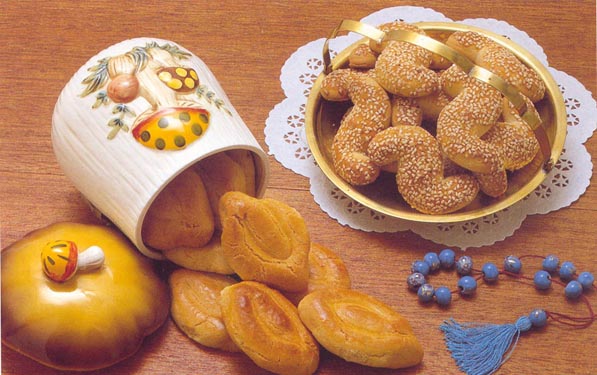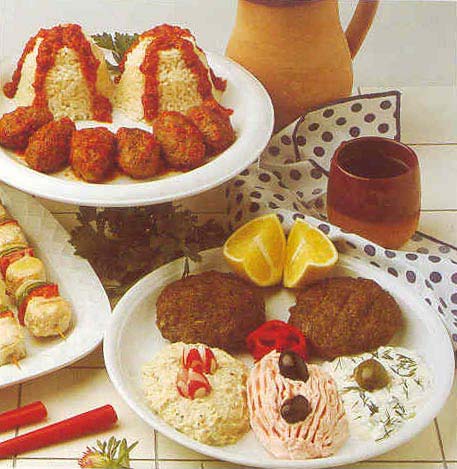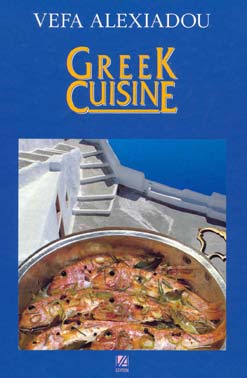 SMYRNA COMMEMORATIVE SERIES  |
||||
|
A Review of Greek Pastries and Desserts and Greek Cuisine by Vefa Alexiadou. Two sample recipes from Smyrna.
By Mary Papoutsy Introduction History books will attest to the cosmopolitan milieu of Smyrna before the Catastrophia in 1922. The port was a bustling hub of multiculturalism and import-export activity, one of the most wealthy and productive areas of all Asia Minor. But, above all, it was Greek in language and culture. Amid this elegant and vibrant background, Greek customs flourished and were passed from one generation to the other. Traditions of religion, language, cuisine, music, and art flowed through this important center of Hellenism, a beacon for all of Asia Minor. As part of our Smyrna Commemorative Series, Hellenic Communication Service presents two recipes from this jewel of Asia Minor. Although we have found no recipe books devoted entirely to the cuisine of Mikrasia, we highly recommend the texts of Alexiadou, Greece's leading cooking authority. She includes recipes from all areas populated by Greeks, including Smyrna, two of which are featured here. A prolific author, scholar, and television personality, "Kyra Vefa" has set the standard for books on Greek cuisine. She is a "gifted cook who comes from a line of gifted cooks, modernizing Greek cooking using contemporary methods and equipment while retaining authentic flavor." A university-trained chemist, she has also studied nutrition at the University of California at Berkeley. Her love of cooking, combined with her artistic talent and scientific training, make her a well-respected authority on Greek cuisine and a regular on Greece's most popular morning TV show. Among her best-selling books are Invitation to Dinner, Invitation to Cocktails, Invitation to Tea, Invitation to a Children's Party, Greek Cuisine, Greek Pastries and Desserts, and Festive Cuisine.
Title: Greek Pastries and Desserts Author: Vefa Alexiadou Publisher: Vefa Alexiadou, Thessaloniki Printer: Pergamos, S.A., Athens Date: 1991 Description: Hardcover, 160 pages, 8.3 x 4.2, numerous photographs ISBN: 90-85018-7-3 List price: $24.95 Alexiadou is an irrefutable authority on Greek pastries. Not only is Greek Pastries and Desserts written with precision, successfully adapting centuries-old recipes to modern methods, but the arrangement of recipes and their presentation must be lauded. At long last, here is a book that is as visually and aesthetically appealing as it is reliable and accurate. Experienced and neophyte bakers alike will find this handsomely bound tome indispensible.
Recipes are arranged logically in sections under appropriate headings. Alexiadou groups the recipes and photos for Honey Puffs (Loukoumades) and Honey Dipped Pastry Bites (Kourkoubinia), for example, on page 107 under the chapter of "Syrup Pastries and Desserts (Glika Siropiasta)." This chapter opens, as all others, with a general introduction to these pastries, their ingredients, preparation, and presentation, along with a brief historical and cultural background. But here in the introductions readers can clearly see the superiority of Alexiadou's work: she adds information not usually seen in Greek cookbooks, essential information for the successful creation of Greek pastries. She discusses how to preserve fresh nuts, how to work with and keep Phyllo dough moist, and how to prepare the syrup, the key to a perfect dessert. This extra information, along with her beautiful visual images and culinary precision, make her books the best on the market. The remaining seven chapters are arranged with as much forethought: "Preserved Fruits," "Breads and Doughs," "Creams and Ice Creams," "Cakes and Tortes," "Jams and Compotes," "Cookies and Confections," and "Religion and Tradition," a chapter rarely seen in any book on Greek cuisine. Rounding out the book are several helpful sections at the back, a Glossary of Terms , Tips for Measuring Ingredients, Conversion charts for Imperial (Australian, British), Metric (European), and American systems of measurement, Temperature charts, and a Comprehensive Index. As far as we're concerned, this book is a must for every kitchen! 
Smyrna Cookies (Koulourakia Smirneika) Yields 40 Cookies Preparation time 1 hour and 30 minutes Baking time 20 minutes Ingredients 1 cup unsalted butter 4-1/2 cups all-purpose flour 1 teaspoon baking powder ¼ teaspoon baking soda ¾ cup sugar 2 egg yolks ¼ cup milk ½ teaspoon mastic from Chios, ground 1-2 egg yolks, beaten with 2 teaspoons water Directions To clarify the butter, melt it over low heat, cook and refrigerate overnight. The next day, lift off the solidified butter and discard the water. To speed up the procedure, freeze the butter for 1-2 hours. Sift together the flour, baking powder and soda. Cream the butter and the sugar until light and fluffy. Beating continuously, add the egg yolks, one at a time; then add the milk and flavoring. Beating with the dough hook or by hand, gradually fold in the sifted ingredients and knead lightly to form a soft, pliable dough. Roll pieces of dough into 10-inch long, finger-thick strips. Shape each strip into a capital letter "N" figure. Press the edges tightly together to form the cookies into small boat shapes. Arrange them on lightly greased baking sheets and brush the tops with the egg yolk mixture. Bake in a 350-degree-Fahrenheit oven for about 20 minutes. Cool and store in a cookie tin.
Title: Greek Cuisine Author: Vefa Alexiadou Publisher: Vefa Alexiadou, Thessaloniki Printer: Pergamos, S.A., Athens Date: 1989 Description: Hardcover, 160 pages, 8.3 x 4.2, numerous photographs ISBN: 960-85018-6-5 List price: $24.95 Like Greek Pastries and Desserts, Greek Cuisine is an indispensible addition to any kitchen library. Chapters are arranged logically: "Appetizers," "Salads," "Soups and Sauces," "Pies," "Cooked Vegetables," "Meats," "Fish and Seafood," and "Poultry and Game." As with her other fine texts, Alexiadou provides a first-rate introduction to each chapter, including a general cultural and historical background of the recipes of the chapter, followed by more specific instructions on how to work with common ingredients for those recipes. Photos, likewise, appear on every page, beautifully illustrating many of the tasty Greek dishes. Moreover, at the back of the book, the author has included a "mini-dictionary of culinary terms," along with helpful tips for accurate measuring of ingredients, tables of equivalents, oven temperature charts, and a comprehensive index to all recipes. In this book, too, Alexiadou shines. Her organizational skills and chemistry background bring precision and thoroughness to her recipes and presentation. Artistic and aesthetic talents appear throughout in the fine photography and presentation of final products. Kyra Vefa presents another "must-have" for the Greek kitchen. Bravo! Meat Rolls Smyrna-Style (Soutzoukakia Smyrneika) |
||||
 Meat Rolls Smyrna-Style (Soutzoukakia Smyrneika) and Greek Hamburgers (Biftekia) |


